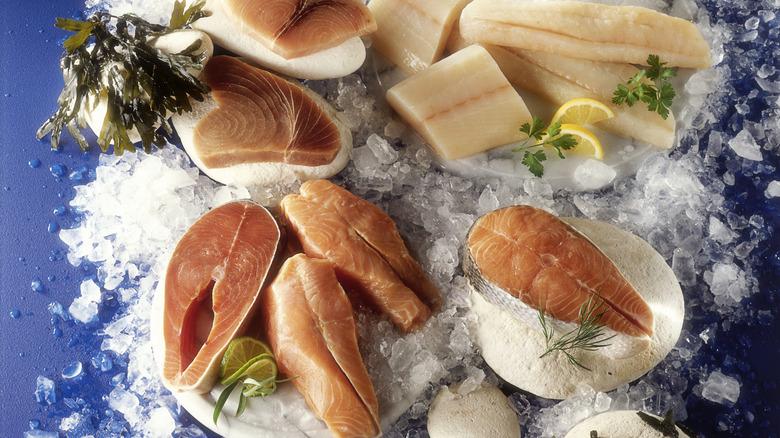The Secrets To Making A Restaurant-Quality Fish Sandwich
The fried fish sandwich is a delicious alternative to a classic burger. Typically made with flaky white fish and featuring a light and crispy fried crust, it's the perfect blend of savory, sweet, and salty. And while this sandwich may seem straightforward at first, restaurants put a lot of effort into making sure that each element — from the fish itself to the bun to the toppings — are made perfectly to deliver a memorable, delicious dish.
We asked Richard LaMarita, chef-instructor at New York's Institute of Culinary Education and Jim Foster, owner at Pelican Seafood Market & Grill in Ottawa, Ontario — Canada's capital city — about restaurants' best kept secrets to producing the best fish sandwiches.
"You should be able to taste the fresh and natural flavor of the fish without it being overwhelmed," explained Foster. "A well-balanced fish sandwich complements the fish with thoughtful additions rather than masking it." That, however, is easier said than done. Read on to discover these insider tips so you can recreate your favorite restaurant fish sandwiches at home.
Only source high-quality seafood
According to both of our experts, every amazing fish sandwich starts with one thing: superb ingredients. "The foundation of any great meal starts with top-notch ingredients. Great ingredients make great food!" said Jim Foster. Fresh, sustainably sourced seafood has better flavor and a higher quality you can taste.
While restaurants often source their ingredients from wholesalers or specialty suppliers, luckily, home chefs can still find the ingredients they need to recreate their favorite fish sandwich. "I would shop at a seafood market before a grocery store every time," explained Jim Foster. "Grocery stores rarely give ... seafood the respect and attention they require to provide top quality."
Richard LaMarita also has a few tips for at-home chefs when shopping for seafood. Look for fish with clear eyes, red gills, and shiny scales. Contrary to popular belief, fresh fish shouldn't have an unpleasant or overpowering smell. Instead, it should have a mild, salty ocean aroma. If you get a whiff of an intense fish odor, it could mean the product is several days old.
Carefully pick the right kind of fish
When making a fish sandwich, not all seafood is created equal. White fish is typically used for classic fish sandwiches (like the iconic McDonald's Filet-O-Fish) thanks to its low fat content and mild flavor. These popular fish varieties, like halibut and cod, are also beloved for their versatility, pairing well with a wide range of spices and toppings. They also have a delicate texture that can be prepared in many different ways — including fried. "[Flaky white fish] are delicious and tender and are mild enough to complement a sauce," explained Richard LaMarita.
Jim Foster agreed: "If you are looking for a fried fish sandwich, panko-crusted cod or haddock are delish. If you want to splurge, fresh halibut is spectacular."
But for restaurants looking to think outside-the-box, there are other fish that can be turned into delicious, less-traditional fish sandwiches. "Salmon tails are awesome grilled or seared on a cast-iron pan," added Foster. "The tails are thinner than regular fillets which gets them crispy, and they are completely bone-free." An added bonus? Salmon is also more nutrient-dense than white fish thanks to its plentiful omega-3s and other healthy fats — though both are lean, delicious, and healthy proteins.
Think about the best preparation
"Generally, the fish in a sandwich is breaded — but not always," explained Richard LaMarita. While fried fish sandwiches are classic, the way the fish is cooked depends heavily on what type of seafood is being used and the flavors of the sandwich as a whole.
Fried fish is usually the go-to style for flaky and delicate white fish sandwiches like haddock, cod, or halibut. But for other fish like salmon, mahi mahi, or even shellfish like shrimp or lobster, restaurants often opt for alternate cooking methods to better suit the fish's flavor and, most importantly, texture.
Some white fish, like grouper, are very firm. This makes it the perfect fish to grill or pan sear because it easily maintain its shape. Because salmon is high in fat, it's perfect for making seafood burgers that have a similar texture to that of ground beef or turkey. Or, for a classic preparation with a twist, you can oven-fry white fish to achieve a crispy exterior — without all of the oil of deep frying.
Always prep fish properly
Like all protein, seafood needs to be properly prepped before cooking to achieve the best possible texture and flavor. No matter the preferred variety, the fish should be cut down to size to properly fit on the bun. There's nothing worse than sitting at a restaurant and your sandwich comes to the table spilling out over the sides, making it nearly impossible to eat. All of this can be avoided starting in the kitchen by properly portioning the fish before cooking.
Once properly sized, the fish still requires some additional prep. When frying white fish, it should be soaked in milk for about 20 minutes when removed from the fridge. This not only helps minimize any off-putting, ultra-fishy odors but also enhances the fish's sweet, delicate flavor. After removing from the milk mixture, pat the fish dry to eliminate excess moisture. This will deliver the crispiest coating possible. After the fish is dredged in the chosen mixture, pan or deep fry for a crunchy exterior. If you're not frying your fish, simply pat it dry before seasoning and cooking using the chosen method.
Cook everything to order
Fish sandwiches — and especially ones made with fried fish— should never be prepared or assembled ahead of time to avoid much-dreaded sogginess. When hot, fried food sits, it releases steam that then condenses. This condensation then soaks into the formerly crisp, breaded exterior, causing it to lose its crunch. The condensation can also work its way into the bun, creating a soggy mess of a sandwich that is less-than-appetizing.
To avoid this pitfall, restaurants typically make these sandwiches "à la minute," otherwise known as made-to-order. That way, the fish is not only hot when it is served, but still has a crunchy exterior and a soft, delicious bun that isn't soggy.
To follow this standard at home, simply prep all of your ingredients ahead of time and get them ready to go. When you're ready to serve, it's just a matter of a few simple steps: Cook your fish using your preferred preparation, toast your bun, add the toppings and condiments, and the sandwich is ready to eat.
Aim for a thin, crispy coating
If opting to make a classic fried fish sandwich, proper technique is required to achieve a coating that is crispy and delicious — not oily and soggy. When prepping, the fish must be patted dry to removed excess moisture. Then, dredge the fish in flour mixed with your chosen seasoning, and dip into beaten eggs. These eggs will help your fried coating adhere to fish and prevent it from falling off during frying, so it's a crucial step. Finally, coat the fish in breadcrumbs to create the signature crisp exterior.
Once the fish is ready to fry, drop it into "clean, 375 degree[s Fahrenheit] canola oil until golden brown. Remove the fish from the oil and let it rest on a cooling rack for a minute," explained Jim Foster.
To achieve a light coating, Richard LaMarita also explained that restaurants sometimes add a few unexpected ingredients to the batter. "Try a beer batter or a batter with seltzer," he recommended. "The basic ingredients for the batter will be beer or seltzer mixed with flour and some cornstarch, which helps with lightness and crispiness." This will make the coating "thin and crispy with a nice color, not thick and crunchy like fried chicken." That way, you get the perfect bite.
Don't skimp on seasoning
No dish is complete without the proper seasoning, and the same rule applies for fish sandwiches. All fish — no matter the variety or chosen preparation — should be seasoned with salt and pepper at the bare minimum. Salt brings out the fish's natural flavors, enhancing its sweet and umami notes. While restaurants tend to liberally salt dishes, home chefs can sometimes be shy with this all-purpose seasoning. As a rule of thumb, use 1 teaspoon of salt for every pound of fish.
In addition to these two must-haves, additional seasonings are the ideal way to play around with fish sandwich flavors and put your own stamp on this classic dish. "If you want to add personal touches, add some paprika or onion and garlic powder to the batter," recommends Richard LaMarita. "If you're feeling adventurous, try a dash of turmeric, a touch of Parmesan cheese, or lemon zest to take your sandwich to new heights." Don't be afraid to also experiment with more unexpected elements like blackening seasoning, jerk seasoning, chipotle, or other powerful flavors to make your fish sandwich one-of-a-kind.
Don't settle for the wrong bun
When it comes to making a fish sandwich, "the bun is a big decision," said Richard LaMarita. There are a few key factors chefs consider when selecting the right bun for their sandwich. The texture and flavor of the bun both come into play when making your selection. While buttery brioche buns are a time-tested classic that pairs well with most fried fish sandwiches, LaMarita recommended exploring other options, too — especially if experimenting with less-traditional flavors.
Potato buns offer a more earthy alternative to brioche, while still delivering the same soft, melt-in-your-mouth texture. Pretzel buns, on the other hand, are an unexpected option thanks to their chewy exterior and pillowy interior. They also have a slight hint of salt and a subtle malted flavor that perfectly complements fried fish. Other less-commonly used buns include sourdough rolls, slider buns, or the Italian classic, ciabatta.
While there are endless exciting and delicious bun options out there, when in doubt, stick with what works according to Jim Foster. "We recommend a soft white roll from a great local bakery for the perfect balance of texture and flavor," he said. Whatever you choose, don't forget to toast and butter the bun to level up the flavor.
Add an unexpected, flavorful sauce
No sandwich — fish or otherwise — is complete without the right condiments. Tartar sauce is the default option for a fried fish sandwich. The creaminess and acidity of this staple sauce (made with mayo, capers, and lemon juice) complement the mild flavor of white fish varieties like cod and tilapia.
Though tartar sauce is the standard, restaurants often experiment with other flavors to develop inventive takes on this classic. Richard LaMarita, for example, recommended "a creamy mayo-based sauce like a curry aioli." This approach introduces Southeastern Asian spices to the sandwich, creating something bursting with flavor that is a surprising — and delicious — alternative to regular tartar sauce.
Jim Foster has a slightly different approach. "For a tangy kick, mix finely chopped dill pickles with a high-quality mayonnaise," he said. The sour flavor of the pickling vinegar, the herbaceous flavor of the dill, and the salty finish all contrast with mild fish flavors to create an opposites-attract effect.
Choose toppings with texture in mind
Even the crispiest fish sandwiches need some textural contrast. The combo of the flaky fish and soft, fluffy bun can lead to a meal that feels a bit mushy if not finished properly. "[Add] some crunch in the sandwich like a slaw or a pickle such as a carrot or cucumber," said Richard LaMarita. "I recommend starting with a base of crispy lettuce to add freshness and texture," added Jim Foster.
Getting creative with the toppings also allows the opportunity to incorporate other flavors to finish out the sandwich and complement your chosen sauce. As a starting point, think about which vegetables have the crisp, crunchy texture that will offset the soft fish. While tomatoes, lettuce, and slaw are classics, don't be afraid to experiment with less conventional add-ons. Green papaya slaw on a curry fried fish sandwich or chipotle and pineapple slaw on a Mexican-inspired dish not only amplify the flavors, but also elevate the typical fish sandwich beyond ordinary.
Thoughtfully select your sides
At a restaurant, it's rare that you just receive a sandwich. Most sandwiches, wraps, and burgers are served up with signature sides that round out the meal like french fries or a side salad. And while these classic companions are delicious with a fish sandwich, there are also nearly infinite options out there that pair well with this delicious dish.
"Serve your fish sandwich with oven-roasted asparagus, zucchini fritters, or a broccoli salad," recommended Richard LaMarita. Looking for something even more unexpected? "[A salad of] curried pears, goat cheese, and romaine, sweet and spicy green beans, or a classic Caesar salad will also enhance the overall presentation [of your sandwich]," he added.
But if you want something with a little crunch and the perfect hint of salt, look no further than a sandwich's longterm partner: the perfect potato chip. "Kettle chips are an excellent side dish for a fish sandwich," said Jim Foster. "The crispy texture provides a satisfying contrast to the tender fish and soft bun."











